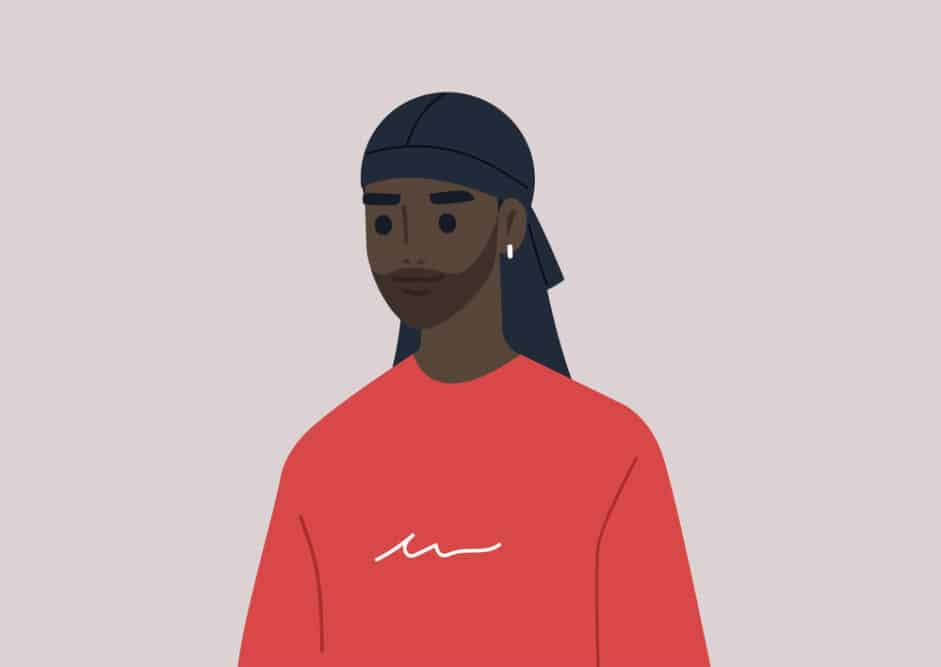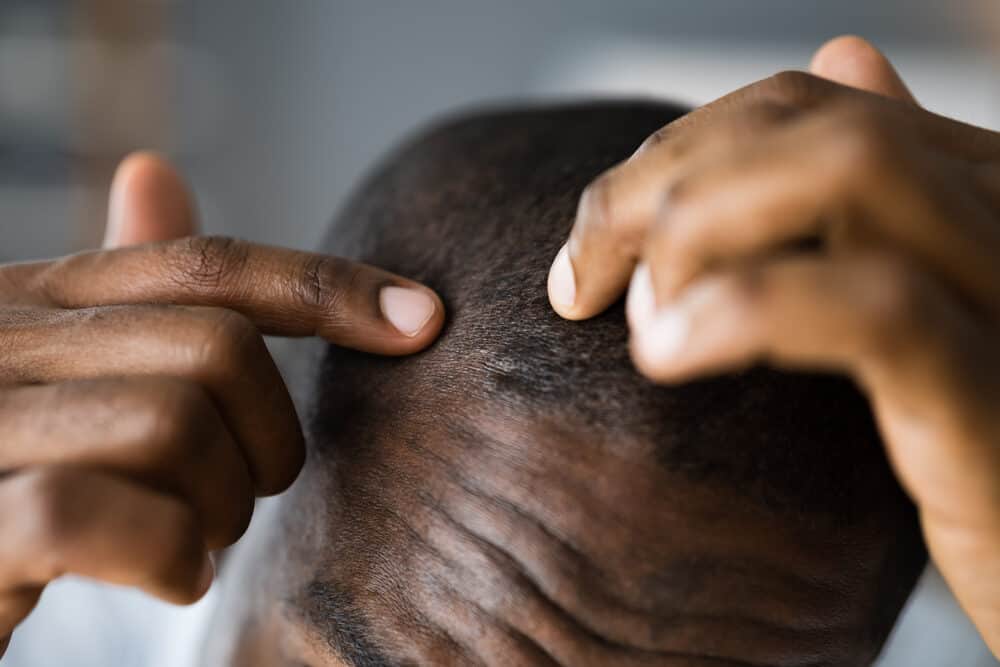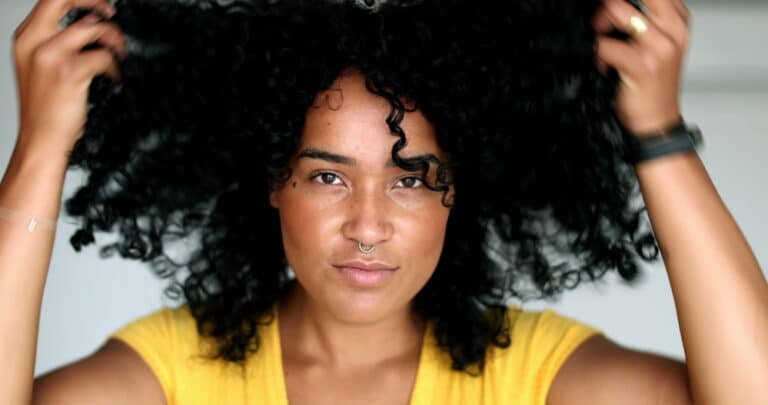Does Wearing a Durag Cause Hair Loss, Baldness, or Thinning?

Durags serve many purposes when it comes to textured hair care, including starting waves, flattening styles, and protecting the hair from the outside elements.
They are so popular, in fact, that most Black people have one or more of them lying around their homes. We clearly love our durags, but it’s impossible to ignore the rumors stating that durags cause hair loss (e.g., female pattern baldness, receding hairline).
If you’re wondering whether these rumors could be true, we can help. In this article, we will examine whether durags are capable of causing hair loss.
Table of Contents
Does Wearing a Durag Cause Hair Loss?
Durags do not cause hair loss. They are usually made of a silky, satiny material that won’t snag or break your hair. They can also be tied as tightly or loosely as you’d like so as not to suffocate your hair follicles.
Therefore, durags in and of themselves are not linked to hair loss. However, misusing durags can cause hair loss.
If you’re dealing with hair loss after using durags on a long-term basis, it could be that you’re not wearing it correctly or that you’re neglecting your hair for long periods. Neglecting the hair is a common cause for many hair loss sufferers.
How Improper Durag Use and Hair Neglect Cause Hair Loss
We’ll begin by telling you how a durag should be used and then get into how it’s often misused.
A durag should be placed on top of your head, with the longest portion hanging loosely in the back. The fabric should be flat all around with no bunching or rolled-up edges.
Once that’s done, take the long strings on the sides, cross them around the back of your head, then cross them at the front of your head, and then finally tie them securely at the back.
Wearing a Durag Too Tightly
Durags should not be tied too tightly, and there are a couple of good reasons why. In this section, we’ll outline each reason:
Follicular Irritation Impeding Hair Growth
Hair follicles need oxygen to grow hair and anchor your strands to your scalp. If you wear a durag too tightly, you cut off the oxygen supply to your follicles, preventing them from breathing freely.
You may experience irritation as a result. Itchiness is a common byproduct of scalp irritation, and when you scratch to relieve the itch, you could end up damaging your hair follicles or even triggering an infection that causes you to lose hair unnecessarily.
Scalp Circulation Issues
If you’re tying your durag so tightly that it leaves an indentation on your scalp or makes your scalp feel numb, your scalp’s blood circulation may be impaired. Without an adequate supply of blood to your follicles, hair loss may naturally follow.
Traction Alopecia Causing Receding Hairlines and Other Harmful Effects
Traction alopecia is hair loss from repetitive or excessive follicle stress or pressure. You can get it if you wear your hair in certain styles too often or manipulate your hair in a way that puts pressure on your hair follicles.
Traction alopecia is often experienced by those who wear their hair in tight braids or weaves, but an ill-fitting durag can cause the issue too.
It often causes breakage or hair loss around the perimeter of your head. So, if this is the area where you’re noticing hair loss, traction alopecia from the durag could be to blame.
If you’ve experienced this side effect, we recommend working with a hair loss specialist to discuss hair treatment options for your specific hair loss situation.
Neglecting Your Hair
Many people who use durags for their hair (especially men) tend to wear them for a few days or weeks at a time. This is not the best-case scenario for your hair’s health.
Your hair needs consistent moisture, washings, conditioning sessions, and more. And if you wear your durag a lot and neglect your hair, you could experience hair loss.
When you don’t feed your hair what it needs to thrive, it can dry out and get brittle. And then, when you go to brush or style your hair the next time, it’ll be more prone to breakage.
How Tight Is Too Tight for a Durag?
What seems loose to one person may be too tight. So, let’s take a moment or two to explore just how tight is too tight for a durag.
Here are some signs that your durag is too tight:
- Pain. If you feel any pain while wearing your durag, that’s a surefire sign that it’s too tight. Wearing a durag shouldn’t be associated with any discomfort.
- Tingling or numbness. Shortly after putting your durag on too tight, you may feel some tingling or numbness on any part of your scalp or head. This is a sign of impaired circulation, and if you don’t loosen up your durag, you could experience the follicular issues we mentioned previously.
- You have trouble taking it off. You shouldn’t have to perform a circus act to unravel the knot in your durag. A difficult-to-unravel knot is a sign that it may be too tight.
The durag should be secure enough not to fall off as you sleep or go about your day. It should lie flat against your head and not move freely.
To check whether your durag is too tight, stick your pointer finger under the strings as they criss-cross at the front of your head. If you cannot comfortably get your finger under them, your durag is probably too tight.
Types of Durags
There are several durag types available on the market as they become more of a fashion trend. Some durags are made of velvet and others of a slippery material, like silk or satin.
Silk and satin are the preferred materials for headwear among people who want to preserve their hair’s moisture levels and guard against hair loss.
We recommend that you go for this material if you’re going to use durags regularly.
Velvet durags are not necessarily bad, but they won’t glide over the hair as smoothly as silk or satin would. So, we always advise silk or satin over velvet durags.

Other Causes of Hair Loss to Consider
If you’re experiencing hair loss, it’s wise to know what factors could be in play. In this section, we’ll get into the top hair loss contributors among people with natural hair.
- Traction alopecia from braids and tight hairstyles. Black people are sometimes known for wearing elaborate hairstyles – unfortunately, these styles are often done too tightly and pull at the scalp until the hair follicles give way. Hair loss from traction alopecia is usually permanent making hair regrowth unlikely.
- Breakage. Textured hair and breakage seem to go hand in hand, given that curly hair is notoriously dry by nature. Prolonged dryness can easily balloon into brittleness and breakage. Breakage is less likely to occur when durags are worn on straight hair.
- Alopecia areata. This form of alopecia, regularly seen in African Americans, is an autoimmune disorder characterized by hair falling out in patches. Stress is a significant contributor to alopecia areata.
- Improper hair care. Leaving your curls to their own devices is one of the quickest ways to jumpstart hair loss. Curls have many twists and turns that make it difficult for the scalp’s oils to make it down the hair shaft and keep the hair moist. For that reason, it’s in your best interest to keep your hair adequately moisturized and conditioned. If you don’t take a proactive approach to hair care and learn what your curls like and dislike, the consequence could very well be hair loss.
- How To Grow Out Baby Hairs on Hairline
- Why Does My Hair Grow So Fast in One Month?
- Does Naturally Curly Hair Grow Slower?
- How Long Does It Take for Hair To Grow Back After Hair Loss
Seeing more hair in your brush or bald spots on your head is alarming. Adding to the initial dismay is the fact that there are so many potential hair loss contributors out there.
It can be challenging to pinpoint what’s causing the hair loss, but in the grand scheme of things, your durag is likely not a factor.
That is if you have been using it correctly, even if you wear it on your hair regularly. We hope that this article was helpful to you and wish you the best with your hair’s health.






